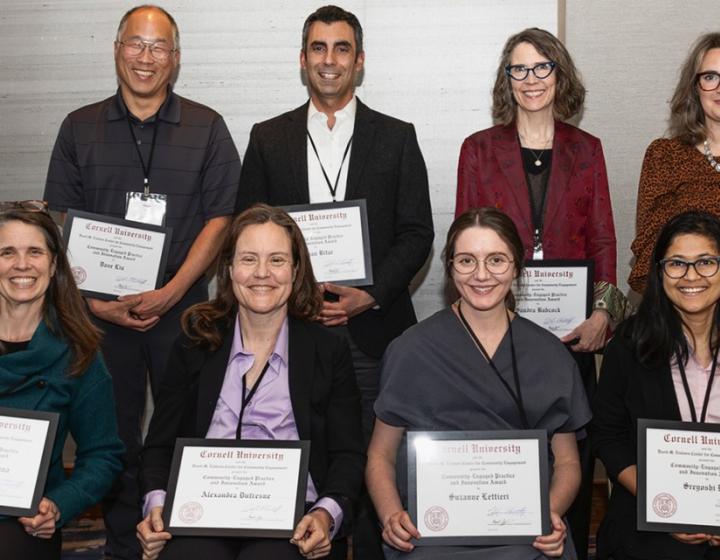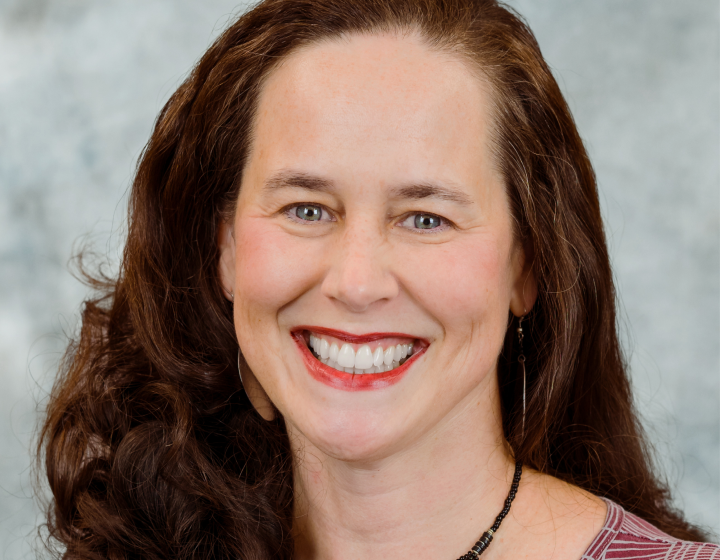CVM's Kraus joins farriers' hall of fame

Cornell Head Farrier Steve Kraus was inducted into the International Horseshoeing Hall Of Fame in Louisville, Kentucky on February 4, 2016. Founded in 1992 and located in the Kentucky Derby Museum, the hall honors farriers around the world who have made significant contributions to the profession. Nominations are submitted by peers, trainers, veterinarians, horse owners, friends and family members, and winners are chosen by current hall members.
A video overview of Kraus's career, narrated by his predecessor Mike Wildenstein, was played during the ceremony and can be viewed on YouTube.
In an interview just prior to the event, Kraus reflected on his 50 years in the business—and why he has no plans to retire any time soon.
The South Bronx is not a typical environment for learning to shoe horses, but then, Steve Kraus knew at an early age that he didn’t belong there: “I don’t know why.” A fan of the TV westerns of the 1950s, he decided at about age 10 that he would be a cowboy. When his parents decided to send him to sleepaway camp for the first time, Kraus had one criterion: the camp had to have horses. And so he found himself in northern PA, at a camp where the outdoor activities included horsemanship. “It was probably a life-changing experience,” says Kraus. His career aspirations broadened that first year, from the idea of being a cowboy to discovering horsemanship as a real interest.
Kraus also watched the camp horses being shod. “It fascinated me, that you could do this to help a horse. I thought, ‘If I’m going to be a well-rounded horseman, I should know how to shoe’.” The camp owner’s son was also interested, so the owner hired a vet student from Texas A&M for a summer to teach them both.
By the time he enrolled at Cornell University in 1968, Kraus had five years of shoeing under his tool belt. He started his own part time farrier business not long after arriving, picking up customers from the rural towns that surround the Cornell campus. “I thought I knew a fair amount, but what I knew was really very basic,” he says.
It wasn’t long before Kraus turned up at the campus Farrier Shop, where he met Resident Farrier Harold Mowers, who was later inducted into the Hall of Fame. “It was another life-changing experience,” says Kraus. “The idea of therapeutic and specialty shoeing was very new to me. Now I was really seeing what horse shoeing was all about. I became fascinated all over again. I would ask Harold questions, and he was very good to me. I spent a lot of time here, and it opened my eyes to the profession of farriery.”
The industry was experiencing a slump at the time, brought on by the steady replacement of horses with cars, trucks and tractors for transportation and farming.
“A century before, when there were hundreds of thousands of horses working in cities, they had very good tools and shoes,” says Kraus. “When horses disappeared during the Depression and WWII, and the cavalry, which trained the best farriers, went away, it faded to a few older guys preserving the craft and trade. Harold Mowers was one of them. By this time there were very limited options in shoes and tools. I had to learn the craft of making shoes and tools—and a whole new world opened up for me.”
Kraus attended his first horseshoeing contest in 1971 and, thanks to Mowers’ tutelage, he did well, “which inspired me to do more.” Gregarious and easy to talk to, Kraus acquired many new friends and mentors at the contests. He discovered that other farriers were struggling with the lack of choice in shoes and tools, and started a second business, making or procuring, and selling farrier specialty tools such as punches, hammers, tongs and selling horseshoes and nails.
Among his friends at the time was Doug Butler, another eventual Hall of Fame farrier. One day Butler invited Kraus to a meeting with representatives of Mustad, a Swedish company that dominated the market for horse shoe nails everywhere in the world except the United States. The upshot: Mustad hired Kraus as a consultant and began sending him to competitions and conventions to find out what American farriers were looking for in a nail. His friendly, upbeat manner again served Kraus well as he talked to the exhibitors and professionals, and he returned with ideas for new packaging as well as designs for nails that appealed to American farriers. At his urging, Mustad began sponsoring competitions and educational programs for clinicians. Eventually the company became the largest producer and marketer of horse shoes, nails and farrier tools in the U.S.
In a profession that often entails a limited circuit from one barn to the next, Kraus ended up traveling all over the U.S., Canada and South America on behalf of Mustad. “I got to see things I never would have seen on my own,” he says. “I met incredible farriers, stars of the industry, and I learned from every one of them. I even got to spend time at the Mustad factory in Sweden.”
Kraus continues to work with Mustad to improve horse shoe nails. At the same time, they are searching together for the “holy grail”: shoes that do not have to be nailed onto hooves. He helped Mustad pioneer the use of glue-on shoes, although Kraus freely acknowledges that they are more expensive and more time-consuming than nailed-on shoes and best used for therapeutic purposes. He began promoting glue-on shoes for that purpose and therapeutic farriers showed interest, so Mustad began producing the shoes and the tools needed to affix them to hooves. Kraus also field tests new nail designs, tools and hoof care products like Thrush Buster and Tuff Stuff for Mustad.
Kraus became a mentor shortly after starting his own farrier business. “I would run into people who wanted to learn, take them on as helpers for six months, then recommend the program at Cornell. I’ve had a dozen students like that over the years—when they left me, they were ready to be finished off.”
As head of the Cornell Farrier Program, Kraus teaches his students the theory behind basic and corrective horse shoeing and hoof trimming; therapeutic methods; splint fabrication and more, followed by hands-on practice under his supervision. He still travels, giving lectures about horseshoeing topics nationwide. Back at Cornell, Kraus runs an annual Farrier Conference, now in its 32nd year. Professionals from across the U.S. attend to learn the latest techniques as well as the time-honored crafts of blacksmithing and tool making, taught by experts.
His other duties include caring for the feet of patients at Cornell’s equine and farm animal hospitals. This entails trimming the hooves of a steer the size of an SUV one day and devising corrective glue-on shoes for a Thoroughbred colt the next. “It’s like Forest Gump’s box of chocolates,” he grins. “You never know what you’re going to get.”
Kraus is also the farrier for the Cornell Polo and Equestrian Teams. An avid rider and polo player himself, he owns and trains polo ponies at his farm in Trumansburg, NY, plays outdoor polo during the summer, and coaches and umpires for indoor polo at the Cornell Equestrian Center during the rest of the year.
“All horse shoeing is about problem solving,” Kraus declares. That’s why even after 50 years, the profession has lost none of its appeal for him.
“It’s great when a horse comes in with a problem, to say ‘I got this. I know how to make it happen,’ and the horse is immediately better,” he says.

Kraus has no plans to retire anytime soon. “It’s hard work,” he acknowledges, “but I’d do it all over again. It’s been a great ride. I never intended to be where I am. I just jumped on this train and it never stopped—one good opportunity led to another. And it’s gone by so fast.
“With Mustad, I’ve made a mark on the industry,” he says. “I’m continuing to help lame horses. And I’m passing it on to the next generation—my students—giving them a chance at the wonderful life I have had.”
Posted February 8, 2016




